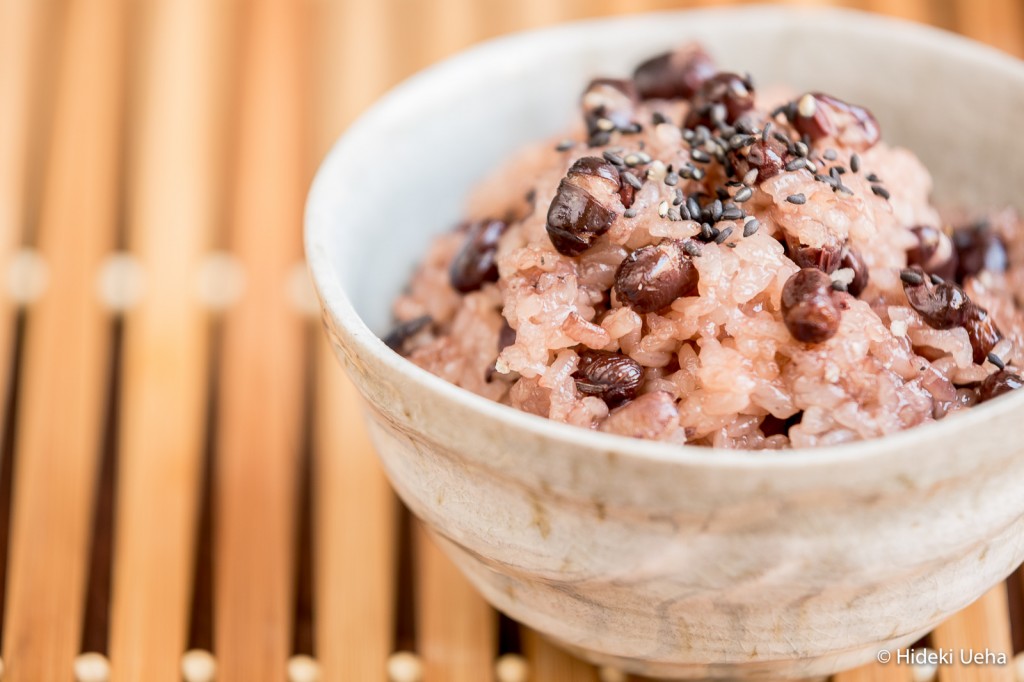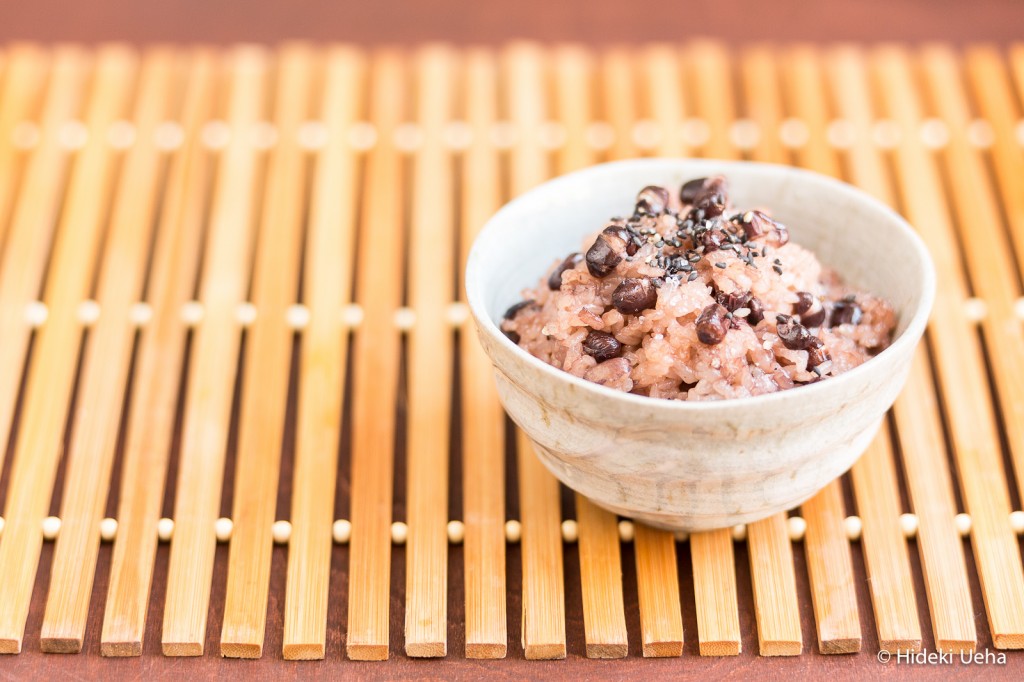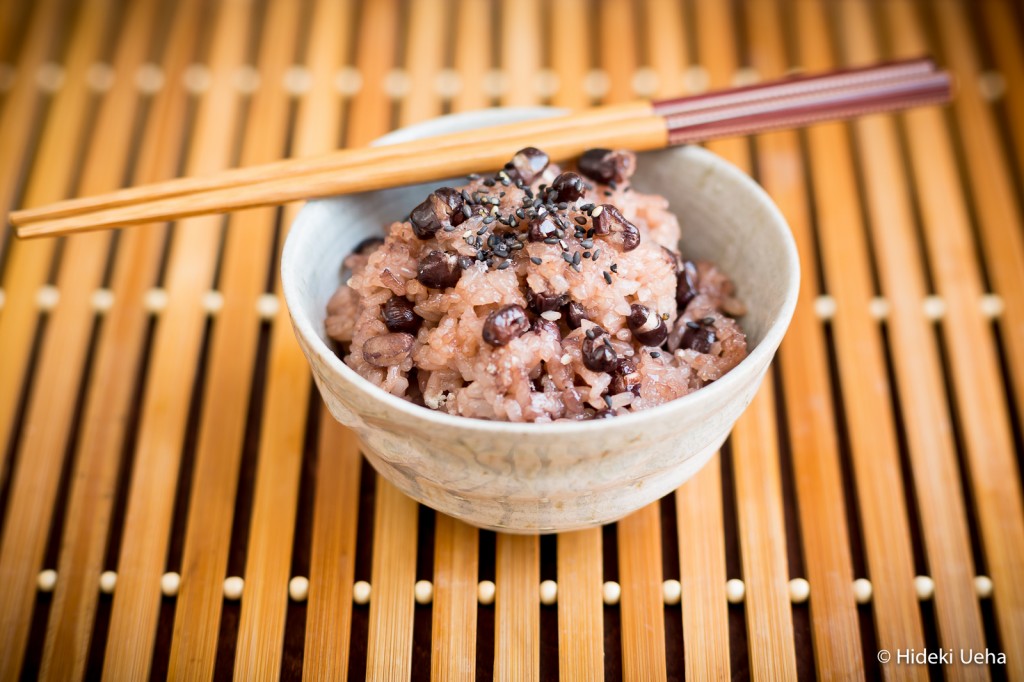Osekihan: Japanese Red Bean Rice
 Osekihan is a celebratory Japanese glutinous rice dish that is often served on special occasions such as the birth of a child, a birthday, an engagement, wedding, special holidays etc. In my Mom’s generation, osekihan was also served to commemorate a young girl coming of age. (Photo Credit: Hideki Ueha)
Osekihan is a celebratory Japanese glutinous rice dish that is often served on special occasions such as the birth of a child, a birthday, an engagement, wedding, special holidays etc. In my Mom’s generation, osekihan was also served to commemorate a young girl coming of age. (Photo Credit: Hideki Ueha)
Osekihan is a simple rice dish that is pinkish-red in color, and sometimes made using glutinous rice and azuki beans. Variations of this involve mixing the glutinous rice with short grain white rice. Sekihan is often served with just a sprinkle of gomashio, or black sesame seeds with salt.
Today, osekihan (also referred to informally as sekihan) is still celebratory in nature, but is also more commonly enjoyed during lunch or dinner. It can be found in the bento (deli) section of our local Japanese supermarkets or enjoyed on a weeknight at home with a simple Japanese dinner.
I learned from my sister-in-law’s parents that pre-cooked cans of azuki (red beans) is available for sale at our local Japanese market and it comes with instructions on how to make “instant osekihan”. Of course, I wanted to experiment with this as well, unfortunately, when I visited a few of the Asian markets in our area that can was not available.
(Photo Credit: Hideki Ueha)
As a child, I never liked osekihan because I never cared for azuki (red beans) but my tastes have definitely changed with maturity. Now, I very much enjoy azuki in zenzai (homemade recipe or instant recipe), and sometimes I enjoy Japanese wagashi (sweets) made with tsubuan (sweet red bean paste recipe). Oddly, today, I don’t mind eating osekihan, and now that I’ve made this a few times, occasionally it’s a nice change of pace from our standard brown rice and my husband rather enjoys it.
Growing up, I don’t really remember my Mom making osekihan, and this is likely because my brother and I never cared for it. When I asked her for her recipe, she was surprised that I was interested in making this but said that she didn’t have one despite the fact that my paternal grandmother used to make it often. Sadly, she passed away years ago before I ever expressed any interest in cooking.

(Photo Credit: Hideki Ueha)
My Dad tells me that my grandmother’s sekihan was not very sticky, indicating that she likely made hers without the use of much glutinous rice, and instead with more regular short grain white rice. There are no rules as far as what proportion of glutinous rice to white rice that can be used, but traditionally osekihan is on the sticky side. Try different variations and see what you prefer the most.
In our family, everyone prefers something different. My Dad prefers osekihan without the use of glutinous rice, my Mom prefers it extra sticky which means using a higher proportion of glutinous rice to white rice. I prefer my osekihan just a little sticky, which is why you’ll see that I’ve only used 1/2 cup of glutinous rice in the recipe below. Experiment, and discover what you like best. Perhaps you’ll love it the the first time you try it, or perhaps you’ll grow to enjoy this traditional Japanese rice dish as I have.
If you’re wondering why I tried my hand at making a dish I never liked, I decided to learn how to make this because it’s a favorite of my Mom’s. I’m glad I tried something new and gave osekihan a “second chance” so to speak. I think in some ways this dish has helped me to grow.
(Photo Credit: Hideki Ueha)
- 2½ cups white rice
- ½ cup glutinous rice
- ½ cup Japanese red azuki beans
- ¼ teaspoon table salt
- Water
- 1 teaspoon roasted black sesame seeds
- ¼ teaspoon crushed Hawaiian rock salt
- Wash azuki beans and drain. Add beans to a pot with 2½ cups water. Boil for 20 to 30 minutes. Drain the beans but reserve cooking liquid and allow it to cool.
- Cover beans with plastic wrap so that the beans do not dry out.
- Wash glutinous rice and white rice until water runs clear. Drain rice.
- Combine rice and beans in the rice cooker, along with ¼ teaspoon table salt and reserved cooking liquid.
- Add additional water according to your rice cooker's measurements to make 3 cups water and steam the rice with the azuki beans.
- Meanwhile, make "gomashio" by combining roasted black sesame seeds and salt. Set this aside.
- NOTE: Black sesame seeds can be purchased roasted. If they are raw, just heat the sesame seeds in a dry pan for about 3 to 5 minutes, continuously shaking the pan or stirring the sesame seeds so that they don't burn.
- Once the rice is cooked, serve osekihan in individual rice bowls and garnish with the black sesame seed and salt mixture.




7 Comments